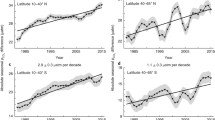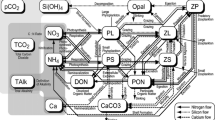Abstract
The uptake mechanism of anthropogenic CO2 in the Kuroshio Extension is examined by a Lagrangian approach using a biogeochemical model embedded in an ocean general circulation model. It is found that the uptake of anthropogenic CO2 is caused mainly by the increase of pCO2 dependency of seawater on temperature, which is caused by greater dissolved inorganic carbon concentration in the modern state than in the pre-industrial state. In contrast with the view of previous studies, the effect of the vertical entrainment, which brings waters that last contacted the atmosphere with the past lower CO2 concentration, is comparatively small. Winter uptake of anthropogenic CO2 increases with the rise of the atmospheric CO2 level, while summer uptake is relatively stable, resulting in a larger seasonal cycle of the uptake. This increase is significant, especially in the Kuroshio Extension region. It is newly suggested that this increase in the Kuroshio Extension region is largely caused by the combined effects of the increased pCO2 dependency of the sea water on the temperature and the seasonal difference in cooling.

















Similar content being viewed by others
References
Anderson L, Olsen A (2002) Air-sea flux of anthropogenic carbon dioxide in the North Atlantic. Geophys Res Lett 29:1835. doi:10.1029/2002GL014820
Aumont O, Orr J, Monfray P, Madec G, Maier-Reimer E (1999) Nutrient trapping in the equatorial Pacific: the ocean circulation solution. Global Biogeochem Cycles 13:351–369
Biastoch A, Völker C, Böning C (2007) Uptake and spreading of anthropogenic trace gases in an eddy-permitting model of the Atlantic Ocean. J Geophys Res 112:C09017. doi:10.1029/2006JC003966
Conkright M, Locarnini R, Garcia H, OfBrien T, Boyer T, Stephens C, Antonov J (2002) World Ocean Atlas 2001: Objective analyses, data statistics, and figures. National Oceanographic Data Center
de Vries P, Döös K (2001) Calculating Lagrangian trajectories using time-dependent velocity fields. J Atmos Ocean Tech 18:1092–1101
Doney S, Lima I, Feely R, Glover D, Lindsay K, Mahowald N, Moore K, Wanninkhof R (2009) Mechanisms governing interannual variability in upper-ocean inorganic carbon system and air-sea CO2 fluxes: physical climate and atmospheric dust. Deep Sea Res II 56:640–655
Follows M, Williams R, Marshall J (1996) The solubility pump of carbon in the subtropical gyre of the North Atlantic. J Mar Res 54:605–630
Follows M, Williams R (2002) Mechanisms controlling the air-sea flux of CO2 in the North Atlantic. In: Follows M, Oguz T (eds) The ocean carbon cycle and climate, NATO Science Series 40, pp 218–249
Gent P, McWilliams J (1990) Isopycnal mixing in ocean circulation models. J Phys Oceanogr 20:150–155
Gorgues T, Aumont O, Rodgers K (2010) A mechanistic account of increasing seasonal variations in the rate of ocean uptake of anthropogenic carbon. Biogeosciences 7:2581–2589
Gruber N, Keeling C (2001) An improved estimate of the isotopic air-sea disequilibrium of CO2: implications for the oceanic uptake of anthropogenic CO2. Geophys Res Lett 28:555–558
Gruber N, Gloor M, Mikaloff-Fletcher S, Doney S, Dutkiewicz S, Follows M, Gerber M, Jacobson A, Joos F, Lindsay K, Menemenlis D, Mouchet A, Müller S, Sarmiento J, Takahashi T (2009) Oceanic sources, skins, and transport of atmospheric CO2. Global Biogeochem Cycles 23:GB1005. doi:10.1029/2008GB003349
Hanawa K, Talley L (2001) Mode waters. In: Siedler G, Church J, Gould J (eds) Ocean circulation and climate. Academic Press, London, pp 373–386
Ishii M, Inoue H, Matsueda H, Saito S, Fushimi K, Nemoto K, Yano T, Nagai H, Midorikawa T (2001) Seasonal variation in total inorganic carbon and its controlling processes in surface waters of the western North Pacific subtropical gyre. Mar Chem 75:17–32
Ishii M, Inoue H, Midorikawa T, Saito S, Tokieda T, Sasano D, Nakadate A, Nemoto K, Metzl N. Wong C, Feely R (2009) Spatial variability and decadal trend of the oceanic CO2 in the western equatorial Pacific warm/fresh water. Deep Sea Res II 56:591–606
Key R, Kozyr A, Sabine C, Lee K, Wanninkhof R, Bullister J, Feely R, Millero F, Mordy C, Peng T (2004) A global ocean carbon climatology: results from global data analysis project (GLODAP). Global Biogeochem Cycles 18:GB4031. doi:10.1029/2004GB002247
Large W, Yeager S (2009) The global climatology of an interannually varying air-sea flux data set. Clim Dyn 33:341–364. doi:10.1007/s00382-008-0441-3
Le Quéré C, Rödenbeck C, Buitenhuis E, Conway T, Langenfelds R, Gomez A, Labuschgne C, Ramonet M, Nakazawa T, Metzl N, Gillett N, and Heimann M (2007) Saturation of the Southern Ocean CO2 sink due to recent climate change. Science 316:1735. doi:10.1126/science.1136188
Lovenduski N, Gruber N, Doney S, Lima I (2007) Enhanced CO2 outgassing in the Southern Ocean from a positive phase of the Southern Annular Mode. Global Biogeochem Cycles 21:GB2026. doi:10.1029/2006GB002900
Maier-Reimer E, Hasselmann K (1987) Transport and storage of CO2 in the ocean: an inorganic ocean-circulation cycle model. Clim Dyn 2:63–90
Midorikawa T, Nemoto K, Kamiya H, Ishii M, Inoue H (2005) Persistently strong oceanic CO2 sink in the western subtropical North Pacific. Geophys Res Lett 32:L05612. doi:10.1029/2004GL021952
McKinley G, Takahashi T, Buitenhuis E, Chai F, Christian J, Doney S, Jiang M, Lindsay K, Moore J, Le Quéré C, Lima I, Murtugudde R, Shi L, Wetzel P (2006) North Pacific carbon cycle response to climate variability on seasonal to decadal timescales. J Geophys Res 111:C07S06. doi:10.1029/2005JC003173
Nakano H, Suginohara N (2002) Effects of bottom boundary layer parameterization on reproducing deep and bottom waters in a world ocean model. J Phys Oceanogr 32:1209–1227
Nakano H, Motoi T, Hirose K, Aoyama M (2010) Analysis of 137Cs concentration in the Pacific using a Lagrangian approach. J Geophys Res 115:C06015. doi:10.1029/2009JC005640
Noh Y, Kim H (1999) Simulations of temperature and turbulence structure of the oceanic boundary layer with the improved near-surface process. J Geophys Res 104:15621–15634
Obata A, Kitamura Y (2003) Interannual variability of the sea-air exchange of CO2 from 1961 to 1998 with a global ocean circulation-biogeochemistry model. J Geophys Res 108:3337. doi:10.1029/2001JC001088
Orr J, Najjar R, Sabine C, Joos F (1999) Abiotic-HOWTO internal OCMIP report. LSCE/CEA Saclay Gif-sur-Yvette, France
Oschlies A (2001) Model-derived estimates of new production: new results point toward lower values. Deep Sea Res II 48:2173–2197
Rodgers K, Sarmiento J, Aumont O, Crevoisier C, de Boyer Montégut C, Metzl N (2008) A wintertime uptake window for anthropogenic CO2 in the North Pacific. Global Biogeochem Cycles 22:GB2020. doi:10.1029/2006GB002920
Sabine C, Feely R, Gruber N, Key R, Lee K, Bullister J, Wanninkhof R, Wong C, Wallace D, Tilbrook B, Millero F, Peng T, Kozyr A, Ono T, Rios A (2004) The oceanic sink for anthropogenic CO2. Science 305:367–371. doi:10.1126/science.1097403
Sarmiento J, Gruber N (2006) Ocean biogeochemical dynamics. Princeton University Press, Princeton
Sarmiento J, Orr J (1992) A perturbation simulation of CO2 uptake in an ocean general circulation model. J Geophys Res 97:3621–3645
Schmittner A, Oschlies A, Matthews H, Galbraith E (2008) Future changes in climate, ocean circulation, ecosystems, and biogeochemical cycling simulated for a business-as-usual CO2 emission scenario until year 4000 AD. Global Biogeochem Cycles 22:GB1013. doi:10.1029/2007GB002953
Schmittner A, Oschlies A, Matthews H, Galbraith E (2009) Correction to “Future changes in climate, ocean circulation, ecosystems, and biogeochemical cycling simulated for a business-as-usual CO2 emission scenario until year 4000 AD”. Global Biogeochem Cycles 23:GB3005. doi:10.1029/2009GB003577
Smith S, Yamanaka Y, Pahlow M, Oschlies A (2009) Optimal uptake kinetics: physiological acclimation explains the pattern of nitrate uptake by phytoplankton in the ocean. Mar Ecol Prog Ser 384:1–12
Takahashi T, Olafsson J, Goddard J, Chipman D, Sutherland S (1993) Seasonal-variation of CO2 and nutrients in the high-latitude surface oceans: a comparative study. Global Biogeochem Cycles 7:843–878
Takahashi T, Sutherland S, Wanninkhof R, Sweeney C, Feely R, Chipman D, Hales B, Friederich G, Chavez F, Sabine C, Watson A, Bakker D, Schuster U, Metzl N, Yoshikawa-Inoue H, IshiiM, Midorikawa T, Nojiri Y, Körtzinger A, Steinhoff T, Hoppema M, Olafsson J, Arnarson T, Tilbrook B, Johannessen T, Olsen A, Bellerby R, Wong C, Delille B, Bates N, de Baar H (2009) Climatological mean and decadal change in surface ocean pCO2, and net sea-air CO2 flux over the global oceans. Deep Sea Res II 56:554-577
Tsujino H, Motoi T, Ishikawa I , Hirabara M, Nakano H, Yamanaka G, Yasuda T, Ishizaki H (2010) Reference manual for the Meteorological Research Institute Community Ocean Model (MRI.COM) version 3, Technical reports of the MRI No. 59
Tsujino H, Hirabara M, Nakano H, Yasuda T, Motoi T, Yamanaka G (2011) Simulating present climate of the global ocean-ice system using Meteorological Research Institute Community Ocean Model (MRI.COM): simulation characteristics and variability in the Pacific sector. J Oceanogr 67:449–479. doi:10.1007/s10872-011-0050-3
Völker C, Wallace D, Wolf-Gladrow D (2002) On the role of heat fluxes in the uptake of anthropogenic carbon in the North Atlantic. Global Biogeochem Cycles 16:1138. doi:10.1029/2002GB001897
Yamanaka G, Ishizaki H, Hirabara M, Ishikawa I (2008) Decadal variability of the subtropical front of the western North Pacific in an eddy-resolving ocean general circulation model. J Geophys Res 113:C12027. doi:10.1029/2008JC005002
Wallace D (2001) Storage and transport of excess CO2 in the oceans: the JGOFS/WOCE Global CO2 survey. In: Siedler G, Church J, Gould J (eds) Ocean circulation and climate. Academic Press, London, pp 489–521
Wanninkhof R (1992) Relationship between wind speed and gas exchange over the ocean. J Geophys Res 97:7373–7382
Watson A, Nightingale P, Cooper D (1995) Modelling atmosphere-ocean CO2 transfer. Philos Trans R Soc Lond B 348:125–132
Wetzel P, Winguth A, Maier-Reimer E (2005) Sea-to-air CO2 flux from 1948 to 2003: a model study. Global Biogeochem Cycles 19:GB2005. doi:10.1029/2004GB002339
Acknowledgments
We thank Dr. T. Midorikawa for many fruitful discussions and comments. Constructive comments from reviewers were helpful in improving the manuscript. Comments from Prof. Y. Yamanaka were very valuable for assessing the basic performance of the NPZD model. This work is funded by MRI and is partly supported by the Japan Society for the Promotion of Science (JSPS) through Grant-in-Aid for Scientific Research on Innovative Areas 22106006.
Author information
Authors and Affiliations
Corresponding author
Appendix: Description of biogeochemical model
Appendix: Description of biogeochemical model
The biogeochemical model includes an ecosystem and a carbon-cycle component. The ecosystem component is a so called NPZD model. All the passive tracer concentrations follow advective diffusive equations with source-minus-sink (SMS) terms of exchange between different tracers. The units of the SMS terms are (mol m−3 s−1).
SMS terms for the NPZD model are
Here Grazing function (G(P)) is \(g\epsilon P^2/(g + \epsilon P^2). \) Other notations and values are listed in Table 2.
The growth rate of phytoplankton (J(I, NO3, PO4)) is limited by either light or nutrient levels. For the nutrient limitation, we adopt the optimal uptake kinetics, which assumes a physiological trade-off between the efficiency of nutrient encounter at the cell surface and the maximum assimilation rate (Smith et al. 2009).
Here \(\tilde{z} = z/\cos\theta = z/\sqrt{{\rm sin}2\theta /1.33^2}\) is the effective vertical coordinate with 1.33 as the refraction index according to Snell’s law relating the zenith angle of incidence in air (θ) to the angle of incidence in water.
For the carbon-cycle component, formulations for the production of DIC and Alk are based on Schmittner et al. (2008, 2009). Production changes in inorganic nutrients and calcium carbonate (CaCO3) in molar numbers are
Surface carbon flux is calculated following the OCMIP protocols.
Rights and permissions
About this article
Cite this article
Nakano, H., Tsujino, H., Hirabara, M. et al. Uptake mechanism of anthropogenic CO2 in the Kuroshio Extension region in an ocean general circulation model. J Oceanogr 67, 765–783 (2011). https://doi.org/10.1007/s10872-011-0075-7
Received:
Revised:
Accepted:
Published:
Issue Date:
DOI: https://doi.org/10.1007/s10872-011-0075-7




